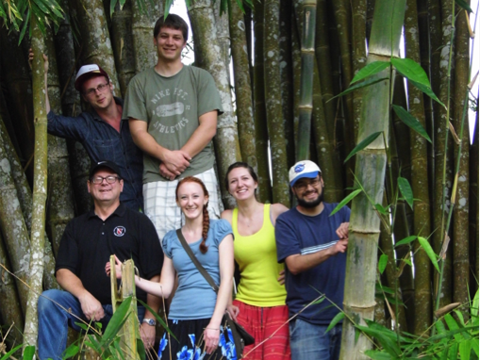 Quantifying and measuring comes second nature to the three Northwest Nazarene University engineering students who traveled to Kudjip, Papua New Guinea, during their Christmas break.
Quantifying and measuring comes second nature to the three Northwest Nazarene University engineering students who traveled to Kudjip, Papua New Guinea, during their Christmas break.
During the two weeks abroad, the students spent their days with various apparatuses and instruments measuring pipe size and water pressure in the hospital buildings. They located and mapped the main lines that carry water across the campus and assessed the amount of power available in the region and surveyed possible locations for a new water tower. Through all this, they found precisely the dire water situation at the Kudjip Nazarene Hospital.
Kudjip Nazarene Hospital, founded in 1967, is a hub for medical access and training in the highlands of PNG. The hospital is equipped to perform all basic health services and a range of major procedures for inpatients and outpatients.
The 185-acre campus uses 80,000 gallons of water in a normal day of operations. A patchwork of tangled systems provides water for the hospital, school, and staff housing, but none of the methods adequately meet the increasing needs of the medical center that serves over 50,000 patients a year. The medical, missionary, and teaching staff of more than 1,000 people get only 32 percent of their daily water from the single well and water tower on near campus.
During the rainy season, two-thirds of the water is supplied by storm clouds. Large, plastic water tanks sit next to almost every building on campus. Rain collected from each roof, fills these tanks, but as soon as the rain stops so does the source of water to replenish the tanks. During the dry season or drought years, water is in such short supply that the single well is overtaxed and red clay-discolored water is pumped up into the hospital and homes.
To address a growing list of health and safety concerns, the hospital asked NNU Professor of Engineering Stephen Parke if the school could offer any assistance. In January 2013, a team of NNU students visited Kudjip to survey the campus and design a 7-year master building plan. They determined a water system upgrade was the highest priority for the hospital. The quality of work done by the students made NNU the hospital’s top choice to take on a new project this year.
The NNU engineering students accepted the task and are using it to fulfill their senior design requirement. They will design a new well, storage reservoir, water purification system, piping network, and pressurization pumps. The upgrade will be funded by a recently awarded $1.5 million USAID grant with construction beginning later this year.
The team included all the skills needed to complete the project. Ryan Lofhouse is a senior mechanical engineering major. He serves as team leader for the entire project. Seth Leija is an electronic engineer who will design the power grid that will run the pumps for the new well. Benjamin Gordan is a mechanical engineer who will focus on the structure of the new water tower. Freshman Krystal Duran is interested in civil engineering and will learn as much as she can from the older members of the team. Partners in the project, Kyle and Chelsie Kaschmitter, also traveled to PNG with the team. Kyle is a civil engineer with Boise State University who is helping the team. Chelsie, an NNU alumna who works for Mission Aviation Fellowship’s media division, documented the project.
During all this technical work, the team also took time to get to know the people.
There are more than 800 unique cultures in PNG. The local residents all dressed in bright colors and welcomed the visitors with extravagant meals, love, and smiles for the camera. And they sang. Bush churches filled with praise and worship in Tok Pisin, Mi laik praisim nem bilong yu, which means, I like to praise Your holy name. Sermons were heated and passionate and the visiting students felt the energy, even if they didn’t understand the words.
This deep passion hints at another cultural identity. The people of PNG have earned a violent reputation and not without reason. The Kudjip Hospital treats many violent injuries caused by clubs and machetes. The U.S. Department of State continually warns travelers to stay away from rural areas and the deep forest, as skirmishes between warring clans are common.
Duran told of her encounter with a man reputed for violence and misdeeds. Appa, a native New Guinean, met with Duran and Lofhouse during a forest hike to Suicide Falls, a beautiful but aptly named cliff overlooking treacherous white water. As they walked Appa began recounting his well-earned reputation. He was known as a thug, a murderer, and a thief for hire. Appa continued his story. One day he was walking and fell into a river. At the bottom of the current, certain he was about to drown, he prayed his first prayer. He prayed for salvation from the river and for his soul.
Appa is a native pastor who leads a church in the bush. He recently finished Bible college and is a leader in the community.
“You could see his passion for the Lord in every movement,” Duran said. “Every other sentence he praised Jesus. The hospital has cared for members of Appa’s congregation and will be better able to continue their service with a stable water source.”
Another local the students met was Gideon. He sits inside the hospital campus every day. Gideon would look worn and haggard if it wasn’t for his smile. For 33 years he has smiled to missionaries, visitors, and every NNU student that visited the hospital. He makes his living decorating wooden tool handles and bamboo. He takes hot embers and by hand engraves intricate designs. He makes machete handles — tools for both farming and violence — look delicate and beautiful. Gideon tells stories while he works; he says making a living from his art is only possible through the hospital. Decades ago his brother brought samples of his work to the hospital, and there has been steady business since.
Leija explained why the students travel around the world, at their own expense, to design a project that won’t make a profit.
“There is a difference between looking at a map of the campus and being there in person,” he said. “On a map we saw an empty field; in person we saw where the staff and students gather to play rugby. We couldn’t just lay a pipe through there; we had to find another option.”
All the data is collected and stored on computer hard drives and in the students’ memories. This semester, back on the NNU campus, the team will analyze the data and design a comprehensive water system that will meet the long-term needs of the Kudjip Nazarene Hospital and the people who benefit from it. The proposal will then be sent to the hospital, completely free of any design charges. Construction of the new well and water tower is expected to begin next year after the hydroelectric dam is ready to power the system. These engineers will be well prepared to improve the lives of whomever they touch next.
NCN News, Northwest Nazarene University




